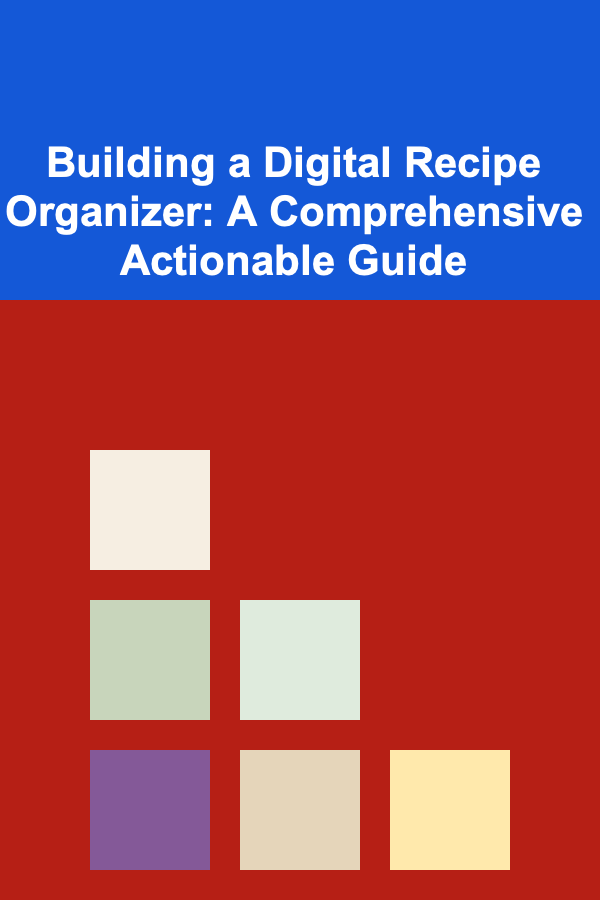
Building a Digital Recipe Organizer: A Comprehensive Actionable Guide
ebook include PDF & Audio bundle (Micro Guide)
$12.99$9.99
Limited Time Offer! Order within the next:

In today's fast-paced world, digital solutions have become essential for simplifying daily tasks. One such task is meal planning and recipe organization. Gone are the days of flipping through countless recipe books or scrolling through numerous sticky notes scattered across the kitchen. A digital recipe organizer can save time, reduce stress, and help you stay organized with ease.
In this actionable guide, we'll explore how to create and maintain a digital recipe organizer that suits your unique needs. Whether you're a home cook, food enthusiast, or professional chef, a digital recipe organizer can help streamline meal planning, grocery shopping, and cooking.
Why You Need a Digital Recipe Organizer
Before diving into the technicalities of building a recipe organizer, it's important to understand the key benefits of using one:
- Organization: A digital system keeps all your recipes in one easily accessible location.
- Convenience: Search and filter recipes by ingredients, cuisine, dietary restrictions, or occasion.
- Customization: Add notes, ratings, and photos for personalized modifications and improvements.
- Time-saving: Quickly find the recipe you're looking for, making meal planning and preparation more efficient.
- Collaboration: Share your collection with family, friends, or collaborators, or create a shared meal planning system.
By organizing your recipes digitally, you'll save time and reduce the effort it takes to plan meals, shop for ingredients, and cook efficiently. The next step is creating your very own digital recipe organizer.
Step 1: Choose Your Platform
1.1 Decide on Software or App
There are many ways to organize recipes digitally, from simple note-taking apps to specialized recipe management software. Consider these options:
- Recipe Organizer Apps : Apps like Paprika , Yummly , Cookpad , and BigOven allow you to save, categorize, and search recipes easily. These apps are designed with recipe management in mind, offering built-in meal planning, shopping lists, and even syncing across devices.
- Cloud Storage Solutions: If you want a more flexible solution, Google Drive, OneDrive, or Dropbox can store documents (like PDFs, Word files, or spreadsheets) that contain your recipes. You can also organize recipes by folders or use a spreadsheet (Google Sheets or Excel) for custom organization.
- Note-taking Apps : Apps like Evernote , Notion , or Microsoft OneNote allow you to create digital recipe books with text, images, and tags. These apps offer flexibility with easy categorization and the ability to store a variety of media.
- Custom-built Solutions: If you have coding skills, you can build your own custom digital recipe organizer using platforms like Airtable or even design a website or mobile app that suits your specific needs.
Each platform offers its own set of features, so choose one that aligns with your organizational style and cooking preferences.
1.2 Cloud Storage vs. Local Storage
One important decision is whether you want to store your recipes in the cloud or on your local device:
- Cloud Storage: Allows access from any device with an internet connection. It's ideal for people who use multiple devices (laptop, phone, tablet) to access recipes.
- Local Storage: Stores files on a single device. This can be useful if you don't need to access your recipes across devices but want them readily available on a particular device (e.g., your kitchen computer or tablet).
Step 2: Organize Your Recipes
2.1 Categorize Your Recipes
The next step is organizing your recipe collection in a way that makes it easy to find what you're looking for. Here are a few methods to categorize recipes:
- Meal Type: Breakfast, lunch, dinner, snacks, desserts, etc.
- Cuisine: Italian, Mexican, American, Asian, Mediterranean, etc.
- Dietary Preferences: Vegan, gluten-free, paleo, keto, low-carb, etc.
- Ingredients: Organize by main ingredients such as chicken, beef, vegetables, pasta, etc.
- Occasion: Holidays, celebrations, weeknight meals, weekend meals, etc.
- Cooking Time: Quick meals (under 30 minutes), slow-cooked dishes, weekend projects, etc.
- Difficulty Level: Easy, intermediate, or advanced cooking techniques.
This structure allows you to quickly locate recipes based on your current mood, dietary restrictions, or available ingredients.
2.2 Use Tags and Keywords
In addition to categories, tags and keywords are valuable tools for enhancing the searchability of your recipes. Tags help further refine your organization. For example, a recipe for a gluten-free chocolate cake could be tagged with:
- Gluten-free
- Dessert
- Chocolate
- Cake
- Sweet
These tags allow you to search for recipes based on specific needs or ingredients. You can also add notes such as "easy", "family-friendly", or "meal prep" for more customization.
2.3 Incorporate Photos and Ratings
Visual elements can make your digital recipe organizer more engaging and informative:
- Photos: Include pictures of the dish at various stages---ingredients, prep, cooking, and the finished product. These visuals not only help you recall the recipe's look but also inspire you.
- Ratings: Add a rating system (1-5 stars) to each recipe based on how much you enjoyed it. This can help you prioritize the best recipes and remember which ones were crowd-pleasers.
Additionally, include space for personal notes. Maybe you altered the recipe slightly or added a twist. Note these changes so you can replicate your favorite variations.
Step 3: Add Meal Planning and Shopping Features
3.1 Meal Planning Calendar
One of the main benefits of a digital recipe organizer is the ability to plan meals ahead of time. By integrating a meal planning feature, you can schedule meals for the week or month. Some digital recipe organizers allow you to create a meal plan, and based on the recipes you select, automatically generate a shopping list.
3.2 Shopping List Integration
Integrate your recipe organizer with shopping list features. When you select a recipe for the week, the system can generate a list of ingredients you need to buy. Some platforms even allow you to check off items as you shop, ensuring you don't forget anything.
Alternatively, if you're using a general note-taking or cloud storage app, you can manually create a shopping list by copying ingredients from your recipe and pasting them into a shopping document.
3.3 Recipe Scaling
When planning meals for multiple people, it's helpful to scale your recipes. Some digital recipe organizers automatically adjust ingredient quantities based on the number of servings. If you're using a general platform like Google Sheets, you can create formulas to scale recipes manually.
Step 4: Regular Maintenance and Updates
4.1 Add New Recipes Regularly
As you discover new recipes, make it a habit to add them to your digital organizer. If you often come across recipes online, many apps and platforms allow you to "clip" or import recipes directly from websites. Alternatively, you can add recipes manually by typing them in or taking photos of handwritten recipes.
4.2 Keep Your Organizer Clean
Every few months, go through your digital recipe collection and clean up any outdated or unused recipes. You may also want to remove recipes you didn't enjoy or no longer want to make. A tidy digital recipe organizer is easier to navigate and will save you time in the long run.
4.3 Backup Your Recipes
Just as you would with any important document, make sure your recipe organizer is regularly backed up. Most cloud-based solutions automatically back up your data, but if you're using local storage, take time to back up your files to avoid losing your valuable collection.
Step 5: Share and Collaborate
5.1 Sharing with Family and Friends
A digital recipe organizer makes it easy to share your collection with others. Whether you want to share recipes with family members, friends, or a wider community, digital systems make this seamless. You can share specific recipes or your entire collection via links, email, or through a collaborative platform like Google Drive or Notion.
5.2 Collaborate on Meal Planning
For larger families or shared living spaces, you can collaborate on meal planning by creating a shared digital organizer. This way, everyone can add their favorite recipes, plan meals for the week, and contribute to the grocery list.
5.3 Engage with Online Communities
If you're passionate about cooking, you might want to engage with other home cooks or chefs through online forums, social media groups, or recipe-sharing platforms. Sharing your digital recipe organizer with these communities can inspire new ideas, recipes, and cooking tips.
Conclusion
Building a digital recipe organizer is a valuable investment for anyone who enjoys cooking, meal planning, and staying organized. By choosing the right platform, categorizing your recipes, incorporating meal planning features, and maintaining your collection, you'll create a tool that simplifies your kitchen routine and elevates your cooking experience. Whether you're a novice cook or a seasoned chef, a well-organized digital recipe system will save time, reduce stress, and help you enjoy the cooking process to the fullest.
Reading More From Our Other Websites
- [Tie-Dyeing Tip 101] DIY Valentine's Gift: Tie-Dye a Heart on T-Shirts, Tote Bags, and More
- [Personal Care Tips 101] How to Choose the Best Fats for a Weight Loss Diet
- [Personal Financial Planning 101] How to Save Money: Smart Tips for Maximizing Your Savings
- [Personal Investment 101] How to Minimize Taxes on Your Investment Gains
- [Rock Climbing Tip 101] Eco-Friendly Climbing Gear: Sustainable Brands and Materials to Watch
- [Home Budget Decorating 101] How to Decorate with Plants on a Budget
- [Home Budget Decorating 101] How to Create a Boho Chic Look in Your Home on a Budget
- [Home Budget 101] How to Use Apps to Help You Stick to Your Home Budget
- [Home Security 101] How to Secure Your Home from Natural Disasters
- [Organization Tip 101] How to Utilize Under-Bed Storage for Maximum Efficiency

How to Add a Touch of Whimsy to Your Holiday Decor with Fun Accents
Read More
How to Declutter Sentimental Items Without Guilt
Read More
How to Make Money Online as a Scientist: 10 Actionable Ideas
Read More
How to Monitor Your Home's Security Remotely
Read More
How to Plan for Big Home Purchases Without Stress
Read More
How to Design Presentations for Different Learning Styles
Read MoreOther Products

How to Add a Touch of Whimsy to Your Holiday Decor with Fun Accents
Read More
How to Declutter Sentimental Items Without Guilt
Read More
How to Make Money Online as a Scientist: 10 Actionable Ideas
Read More
How to Monitor Your Home's Security Remotely
Read More
How to Plan for Big Home Purchases Without Stress
Read More